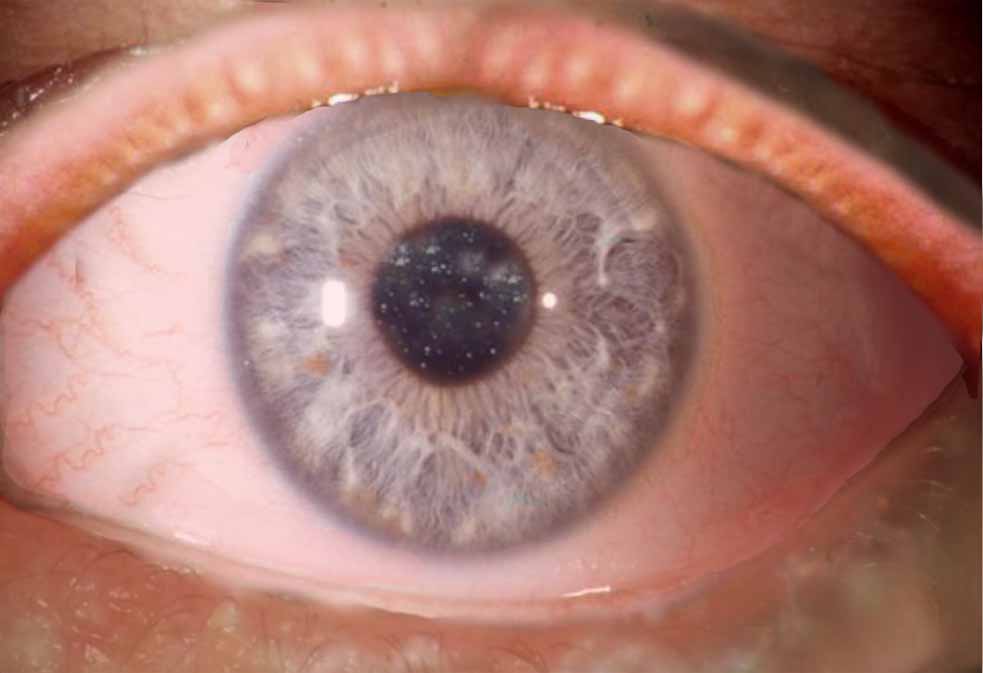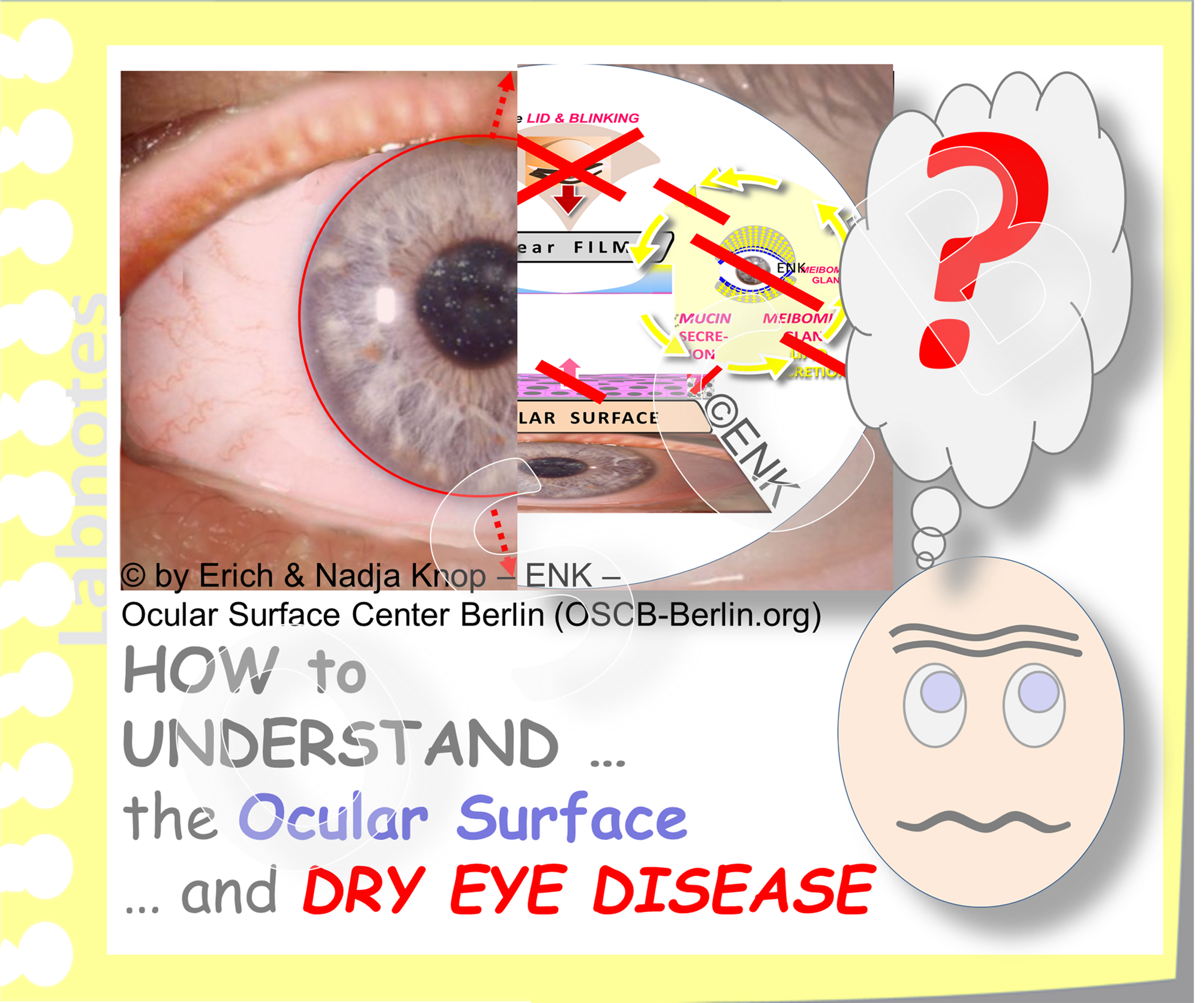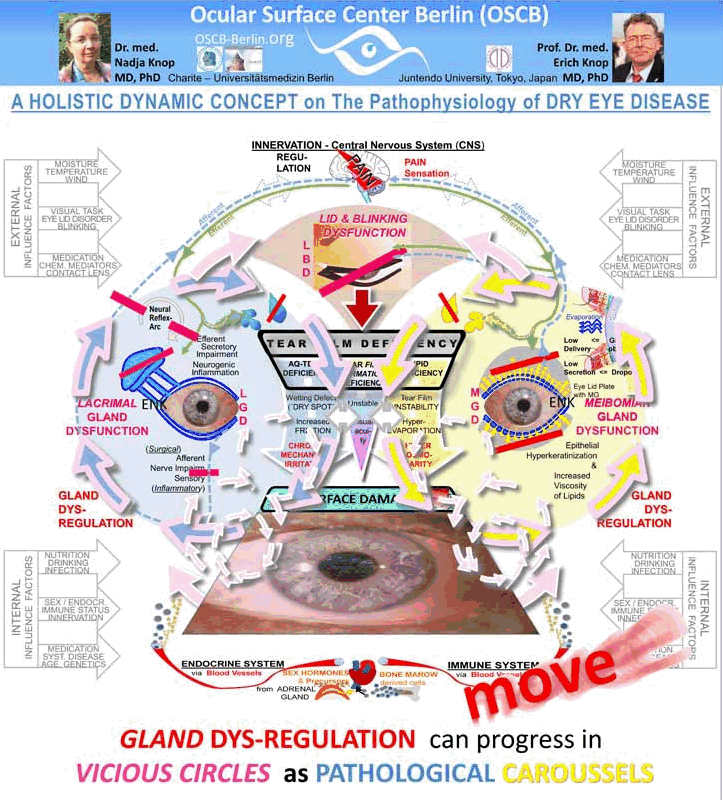DRY EYE DISEASE
Links to some pages:
GLIMPSE on ...
DRY EYE DISEASE
SUMMARY
Dry Eye Disease is a, typically chronic, irritative dysfunction of the Ocular Surface and can lead to progressive tissue destruction. This is a complex dysregulation of the functional anatomy of the ocular surface that causes, via a deficiency of tear film stability, a lack of sufficient surface wetting and thus induces damage of the ocular surface. Both of these pathological consequences give rise to subjective symptoms of the patient and to objective clinical signs. Dry Eye Disease can be amplified by self-enforcing mechanisms that are termed vicious circles and lead to a progression of disease. The new holistic dynamic concept on dry eye disease describes all factors in the disease process in the natural sequence.
Dry Eye Disease is the most frequent diagnosis in ophthalmologic practice. Meibomian Gland Dysfunction (MGD) of the oil producing glands in the eye lids appears as the main causative factor for Dry Eye Disease. This is typically an obstruction of the glands that leads to a lack of oil on the tear film and thus to increased evaporation of tear water with eventual lack of tears and ocular dryness. The Pathophysiology of Dry Eye Disease is influenced by risk factors - internal systemic diseases and environmental desiccating stress factors. Dry Eye Disease represents a considerable burden to the individual and to society.
Some clinical images of patients with Dry Eye Disease - the disease severity increases from left to right including increasing alterations of the lid margin with pouting of Meibomian gland orifices, inflammation, lid margin rounding and irregularity, with loss of eye lashes
Dry Eye Disease is a, typically chronic, Irritative Dysfunction of the Ocular Surface and can lead to progressive destruction
Dry Eye Disease is a complex dysregulation of the functional anatomy of the ocular surface that leads, via a deficiency of tear film stability, to a lack of sufficient surface wetting and thus induces damage of the ocular surface.
Dry Eye Disease can be a ´TRICKY´ Condition
Dry Eye Disease can be a ´tricky´ condition in many respects because it is based on the failure of a complex functional system.
Many factors are inter-related and inter-dependent and must be aligned by the regulatory systems of the body in order to work well - and ´well´ means healthy.
This may be compared to a house of cards where many factors depend on each other to eventually build an apparently stable house ... as long as no single of the cards is moved.
Dry Eye Disease typically occurs ... ´after the MOIST is gone´
Dry Eye typically occurs ´after the MOIST is gone´. Moisture must be provided´everytime and everywhere´ - This refers to the continuous moisture of the complete ocular surface including the tissue within the interpalpebral fissure. If this is not (sufficiently) provided disease will occur.
This disease, which is oversimplified termed as ´DRY Eye Disease´, can have several tricky aspects, that are difficult to understand when the disease process is not fully understood. These Tricky Issues have made the disease condition difficult to understand for a long time and have only been elucidated through intense research in Ocular Surface and Dry Eye Disease.
A Tricky issue therefore is, that not only tear production, but also tear distribution is important for the provision of a stable tear film that is able to protect the tissue ´- everytime and everywhere - because this film of tears is the essential thing that makes the difference between health and disease.
Tricky is furthermore, that the Tear Film needs a suitable ocular surface structure to bind to and rest on. Also issues of tissue integrity thus become of interest ... in addition to sufficient tears and sufficient wiping.
Tricky issues are for example that many patients who suffer from initial stages of ´Dry Eye Disease´ can actually have an overflow of tears with watering eyes. Such episodes of excessive tearing are the result of a protective neural reflex arc that becomes activated due to the ocular irritation that occurs when the tear film is insufficient in incipient Dry Eye Disease ... but the protective reflex is still working.
Another tricky issue is that in many patients with ´Dry Eye Disease´, in fact in 4 out of 5 patients, not water is primarily missing but instead oil.
Tricky is also, that many factors can negatively affect the health of the ocular surface - which typically results in a failure of the basal function of moisture and thus leads to a ´Dry Eye´. It is then important to find out which factor/-s are altered by which influences - this is termed ´"Diagnosis". A good diagnosis is important to find out, which is the best route for re-improving/ repairing the condition - this is termed "Therapy".
Remember: The better the Diagnosis – the more specific and thus effective will the Therapy be – and thus the happier the patient is ... not to tell of the clinician
Therefore the Ocular Surface Center Berlin (OSCB) has set up this Information Platform in order to help elucidate and explain the normal function of the Ocular Surface and its alterations in Dry Eye Disease.
This is also the reason why we are strictly following the pathways of the course of disease - this is termed ´Pathophysiology´ and elucidates what went wrong with the normal condition and why did it happen to find out how it can be cured.
Therefore, we favor Patho-Physiology instead of considering what might presently be considered as more or less ´important´ ... along with the changing fashions in science.
Both of these pathological consequences give rise to subjective symptoms of the patient and to objective clinical findings.
Typical signs and symptoms of Dry Eye Disease
What are the symptoms of DRY EYE DISEASE ?
dryness, grittiness, feeling of ´heavy lids´ or ´tired eyes´
visual disturbance and blurred vision
ocular irritation and pain.
Typical clinical SIGNS in a patient with Dry EYE Disease:
unstable tear film with short Tear Film Break-Up Time (BUT)
low tear volume
thin tear film lipid layer
epithelial wounding
Dry Eye Disease can be amplified by self-enforcing mechanisms that are termed vicious circles and lead to a progression of disease
Vicious Circles are
negative effects from a pathology
within the disease process
that act back on itself and
thus re-inforce further pathology.
The image, from the TFOS Maui congress in the year 2000 an a respective publication, shows the first description of a vicious circle in Dry Eye Disease
Self enforcing vicious circles do not necessarily need an inflammatory process ...
... but inflammatory pathways are important amplifiers of the vicious circles and thus of the disease process as a whole
Self enforcing vicious circles may eventually lead to a progressive destruction of the ocular surface.
Dry Eye Disease is the most frequent diagnosis in ophthalmologic practice
According to Epidemiological Studies roughly about one in six or seven individuals suffers from symptoms of a manifest Dry Eye Disease. The number of individuals who have Meibomian Gland Dysfunction, including the a non-obvious form (NOMGD) without subjective symptoms, is respectively thought to be much higher.
Hundreds of millions of people world-wide suffer from Dry Eye Disease which is the most frequent diagnosis in clinical practice. Epidemiology studies have shown that on average about 5-15% of the population suffer from Dry Eye Disease depending on factors such as age, sex and severity of disease.
Among females and individuals of advanced age, the proportion of dry eye patients is typically higher. There may also be ethnic aspects since Asian studies report frequencies of over 35% of dry eye of their populations.
Meibomian Gland Dysfunction (MGD) appears as the main causative factor for Dry Eye Disease
Meibomian Gland Dysfunction (MGD) is a, mostly obstructive, dysfunction of the Meibomian glands inside the eye lids, that produce tear film lipids in order to retard evaporation of the aqueous tears.
When Meibomian Oil is missing the tear water rapidly evaporates and leads to a lack of tears with increased friction on the Ocular Surface and increased concentration of salts (hyper-osmolarity) of the remaining tears. Both of this has negative influence on the surface tissue.
MGD may be asymptomatic but already destroy the gland tissue due to the increased pressure inside the obstructed glands
In contrast to Dry Eye Disease, MGD also occurs in a form without subjective symptoms of the individual.
Still the increased pressure in the obstructed glands is supposed to cause an invisible destruction of the gland tissue inside the lids.
This condition is termed Non-Obvious MGD (NOMGD).
Therefore the number of individuals who have NOMGD is conceivably distinctly higher than the proportion of Dry Eye Disease. It is assumed that the majority of individuals over the age of 60 years in fact have an obstruction of their Meibomian Glands to varying degrees with an inherent risk of gland destruction.
What we see as symptomatic Dry Eye Disease and obvious Meibomian Gland Dysfunction ... may therefore in fact only be the ´tip of the ice berg´ in chronic ocular surface disease.
The Pathophysiology is influenced by RISK FACTORS – internal systemic factors and environmental stress factors
Several Influence Factors promote Dry Eye Disease. This concerns a reduced level of male sex hormones (androgens) or an increased level of female sex hormones (Estrogens). Advance age and environmental factors that promote a desiccation of the ocular surface promote the risk for Dry Eye.
The pathophysiology of Dry Eye Disease is not yet exactly clear but
it is known that this condition increases depending on internal factors:
with advanced age,
is associated with sex hormone levels and
generally more frequent in females, and
can be associated with systemic disease,
particularly certain skin diseases.
Dry Eye Disease is promoted by risk factors
These are mainly desiccating environmental factors in private life and work environments.
high temperature
low humidity / air conditioning
high wind speed/ fans
can be associated with visual tasks of high concentration thatinclude
reduced blinking frequency
contact lens wear
External RISK FACTORS in the environment typically consist of factors thar promote the desiccation of the ocular surface. This occurs either by direct desiccation though high temperatures, dry air-condition air and wind.
Indirect effects occur through a reduced blinking frequency that decreases the delivery of Meibomian oil onto the tear film and also goes along with reduced reformation of the tear film.
Contact lens wear increases the evaporation rate and contact lenses generally have requirements of a higher volume and quality of tears. This may cause a tear film that is usually just borderline normal to decompensate when a contact lens is inserted.
Dry Eye Disease represents a considerable burden to the individual and to society
ADVANCED AGE together with the health problems that tend to be associated with it, such as chronic diseases and several respective medications, some of which may negatively influence the function and health of the ocular surface, are is one of the main RISK FACTORS for Dry Eye Disease.
... please note - when we tend to become wise unluckily also the risk for Dry Eye Disease increases - whether the opposite is also true is unknown !
Dry Eye Disease is bothersome and leads to a loss in quality of life and in productivity of work.
This represents a considerable burden not only to the health and well being of the individual but also is an economic burden to the health care and social systems.
This is even the more relevant as Dry Eye Disease may likely increase in the future of our aging societies.
Deeper knowledge about all aspects of Dry Eye Disease and novel therapy options are therefore highly desirable.
The PROMOTION of deeper KNOWLEDGE on the Ocular Surface and Dry Eye Disease
is also the Purpose of this ´INFORMATION PLATFORM for the OCULAR SURFACE and DRY EYE DISEASE´
of the OCULAR SURFACE CENTER BERLIN (OSCB) - www.oscb-berlin.org
... when you like the information provided here ... please spread the word !











